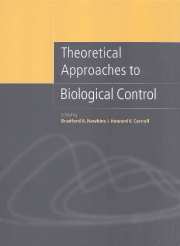Book contents
- Frontmatter
- Contents
- List of contributors
- Preface
- Part I Biological control theory: past and present
- Part II Ecological considerations
- Part III Spatial considerations
- 10 Dynamics of spatially structured spider mite populations
- 11 Habitat fragmentation and biological control
- 12 Outbreaks of insects: a dynamic approach
- Part IV Genetic/evolutionary considerations
- Part V Microbes and pathogens
- Index
10 - Dynamics of spatially structured spider mite populations
from Part III - Spatial considerations
Published online by Cambridge University Press: 13 August 2009
- Frontmatter
- Contents
- List of contributors
- Preface
- Part I Biological control theory: past and present
- Part II Ecological considerations
- Part III Spatial considerations
- 10 Dynamics of spatially structured spider mite populations
- 11 Habitat fragmentation and biological control
- 12 Outbreaks of insects: a dynamic approach
- Part IV Genetic/evolutionary considerations
- Part V Microbes and pathogens
- Index
Summary
Introduction
Laboratory studies of phytophagous and predacious mites were among the first to suggest that spatial structure could dramatically affect predator–prey dynamics (Huffaker, 1958; Huffaker et al., 1963). Space is now a hot topic in much of ecology, and it comes in many guises: dispersal behavior, predator aggregation, environmental heterogeneity, meta-populations, source–sink dynamics, invasions. In the first part of this chapter we present an overview of predator–prey models with spatial structure. The aim is not to provide an all-inclusive or in-depth review of these models. Rather we give a sketch of current approaches, summarizing predicted effects of dispersal on aspects of predator–prey dynamics relevant to the biological control of spider mites. Thus we are primarily concerned with the predictions these models make with respect to prey and predator abundances, prey and predator distributions in space, and persistence of the predator–prey interaction. We then present some predictions based on a more specific simulation model of acarine predator–prey dynamics in a greenhouse environment. Finally we discuss how well the models reflect biological control of phytophagous mites by predacious mites in greenhouses and orchards, and examine the relationship between model predictions and observed dynamics of these systems.
Spatially structured predator–prey models
The incorporation of spatial structure into predator–prey models in the 1970s and 1980s used one of two approaches, reaction–diffusion or patch models (Hastings, 1990).
- Type
- Chapter
- Information
- Theoretical Approaches to Biological Control , pp. 163 - 189Publisher: Cambridge University PressPrint publication year: 1999
- 4
- Cited by

